Struggling to figure out how hungry or full you are? Try using the intuitive eating hunger fullness scale as a tool to help you determine when and how much to eat.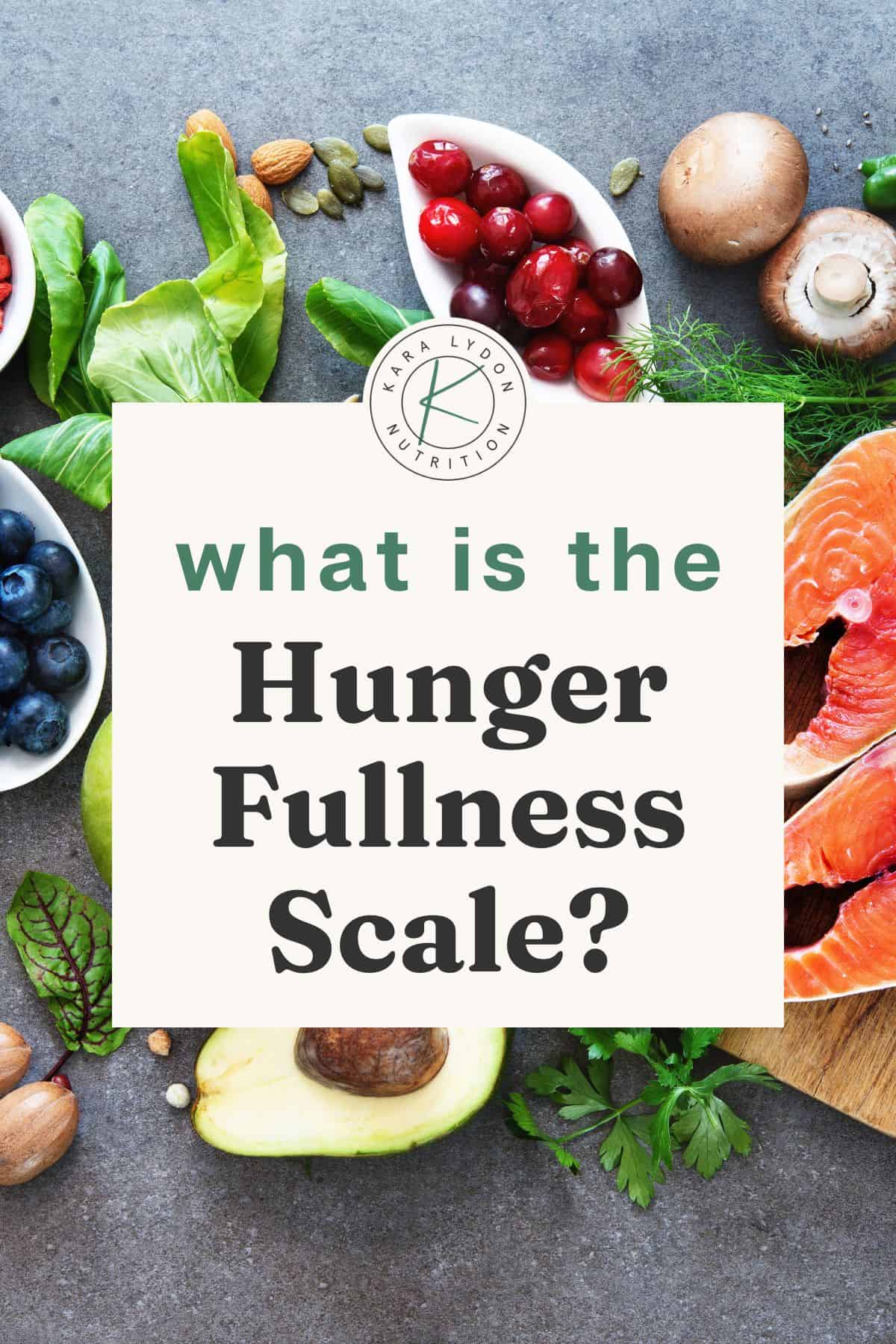 The hunger fullness scale is a tool you can utilize to help practice two of the ten principles of intuitive eating – honoring your hunger and feeling your fullness. As a certified intuitive eating counselor, I find it can be a helpful guide to determine just how hungry you are (aka when it’s time to eat) and how full you are (aka when it might be time to stop eating).
The hunger fullness scale is a tool you can utilize to help practice two of the ten principles of intuitive eating – honoring your hunger and feeling your fullness. As a certified intuitive eating counselor, I find it can be a helpful guide to determine just how hungry you are (aka when it’s time to eat) and how full you are (aka when it might be time to stop eating).
If you struggle with listening to your body or knowing when you’re actually hungry or full, you’re not alone! There are many reasons why this might be the case (more on that below) but one of the most common reasons I see is that people have lost a connection to their body after years and years of dieting.
Diet culture conditions you to believe that hunger is bad and you should override hunger, and if you can override hunger, congrats – you have SO much willpower! After so many years of overriding your body’s signals, your body stops talking because you’re not listening anyway, right?
You begin to lose that interoceptive awareness, the ability to perceive physical sensations that come from within your body, and without proper nourishment, consistency in eating, and body trust, those signals are hard to notice again.
That’s where intuitive eating comes in – you can practice challenging diet culture rhetoric, paying attention to what’s going on inside your body, and eating more adequately to restore body trust.
Getting to know your hunger cues
Most people think about hunger pangs or stomach growling when they think about how hunger shows up in their body but there are SO many other ways you can experience hunger:
Stomach: rumbling, gurgling, gnawing, or emptiness
Throat / esophagus: Dull ache, gnawing, salivating
Head: foggy brain, headache, lightheadedness / dizziness, difficulty concentrating, thinking about food
Mood: irritability (hanger!), anxiety
Energy: decreasing, feeling sleepy, dullness, apathy, overall lethargy
This is not an exhaustive list either – maybe you you notice other symptoms in your physical or emotional being?
These symptoms speak to physical hunger cues but there are other types of hunger too like taste hunger (craving for something specific), emotional hunger (drive to eat because of a strong emotion), and practical hunger or “eating as an act of self care” (eating before you leave the house because you won’t be back home for another 3 hours).
If you’re interested in learning more about hunger, check out my blog post on the signs of hunger and how to know if you’re actually hungry.
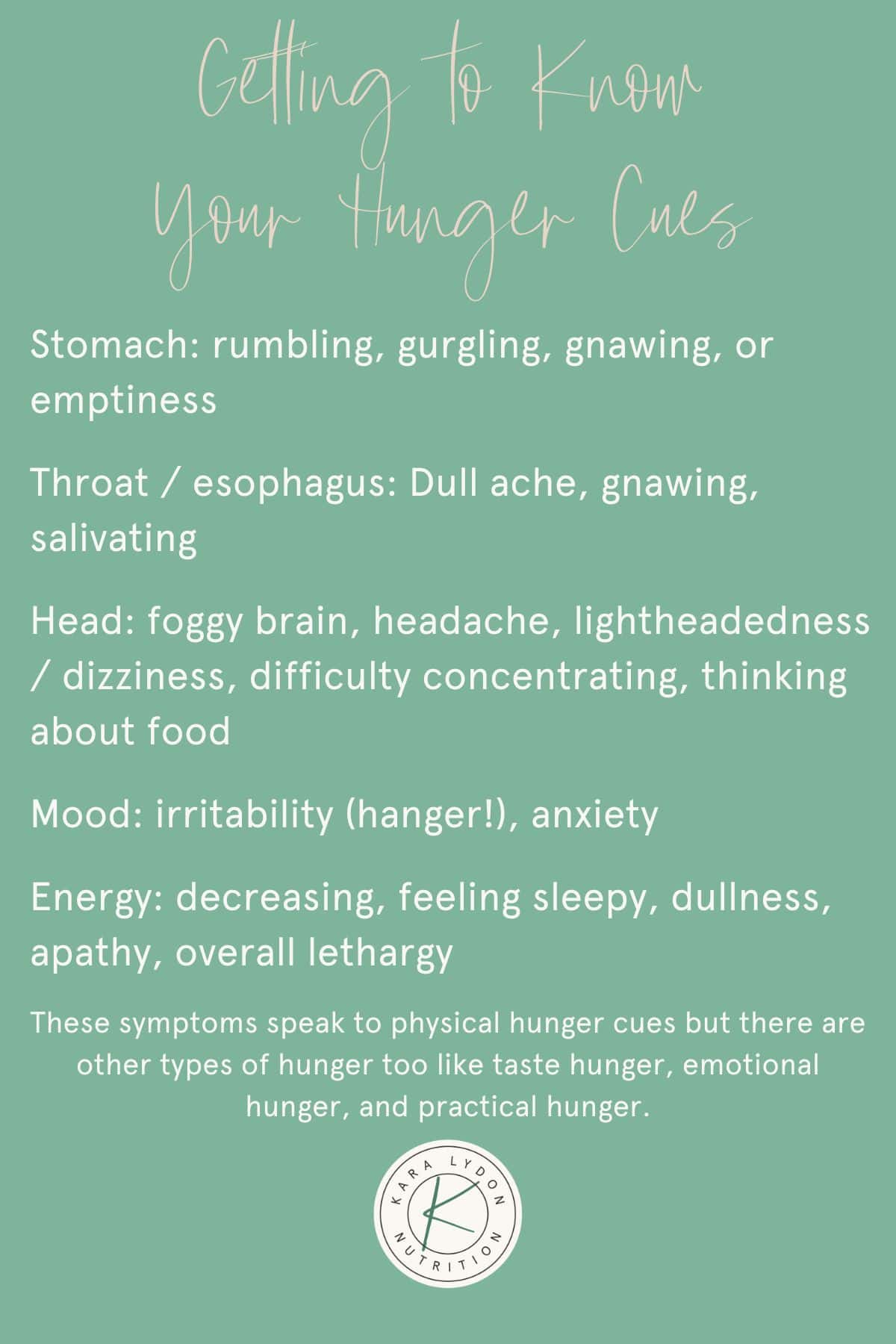
Getting to know your fullness cues
Just as everyone experiences hunger differently, people feel fullness in various ways too.
Stomach: slight distension, heaviness, bloating
Head: less thoughts about food / eating, desire to eat is gone
Mood: begin to feel pleasant and/or relaxed
Energy: some feel reenergized and others might feel drowsy
There are also two different types of fullness – physical (satiety) and emotional (satisfaction). You need both satiety and satisfaction to feel truly full.
For example, you could eat the biggest salad filled with vegetables only and feel physically full after; however, you probably wouldn’t feel satisfied by that meal. You might find that your stomach is distended but you’re still having thoughts about food.
If you added some grains, cheese, nuts, and fruit to that salad, you might feel satiated and satisfied and be ready to move on from that meal and go do something else.
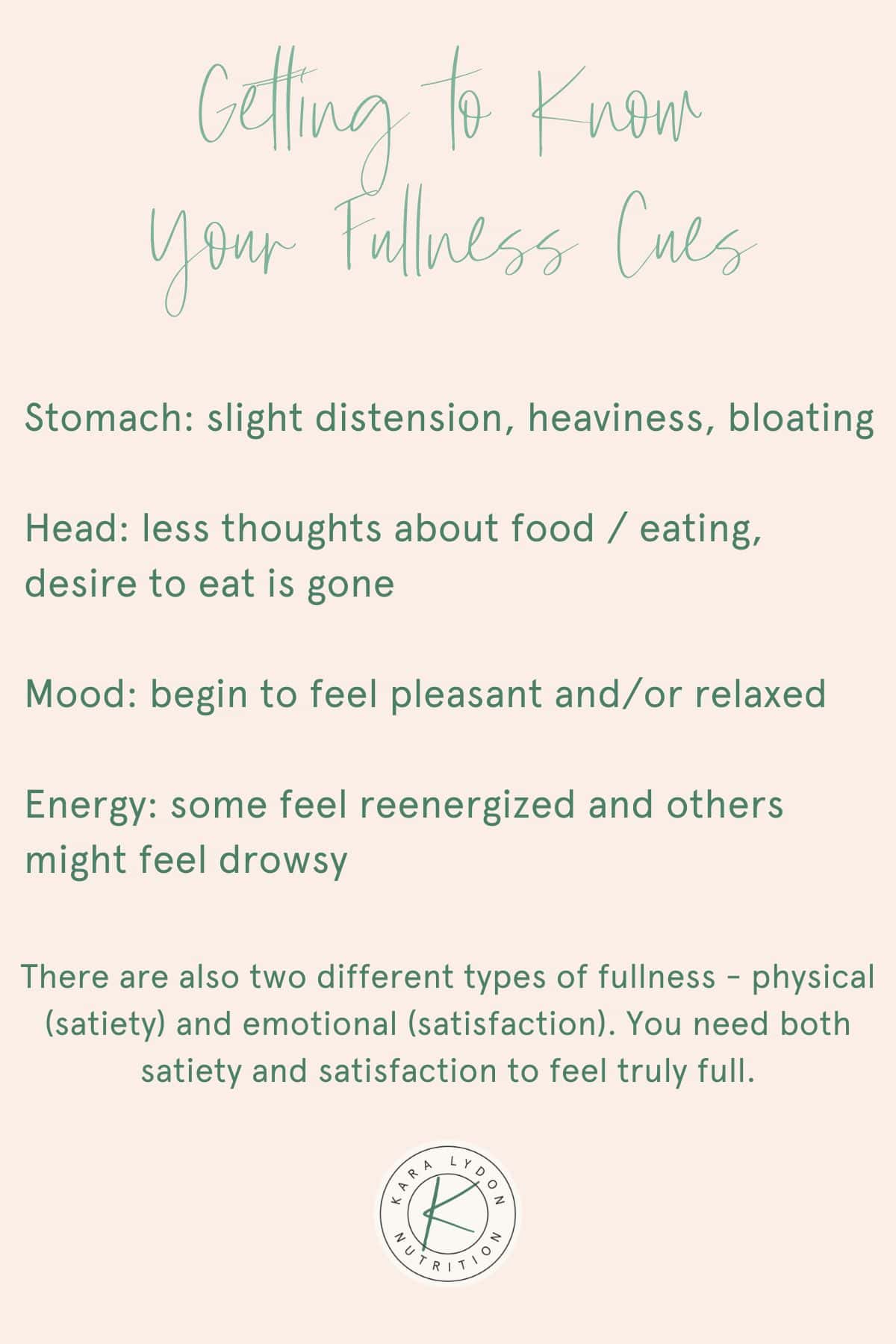
How to use the hunger fullness scale
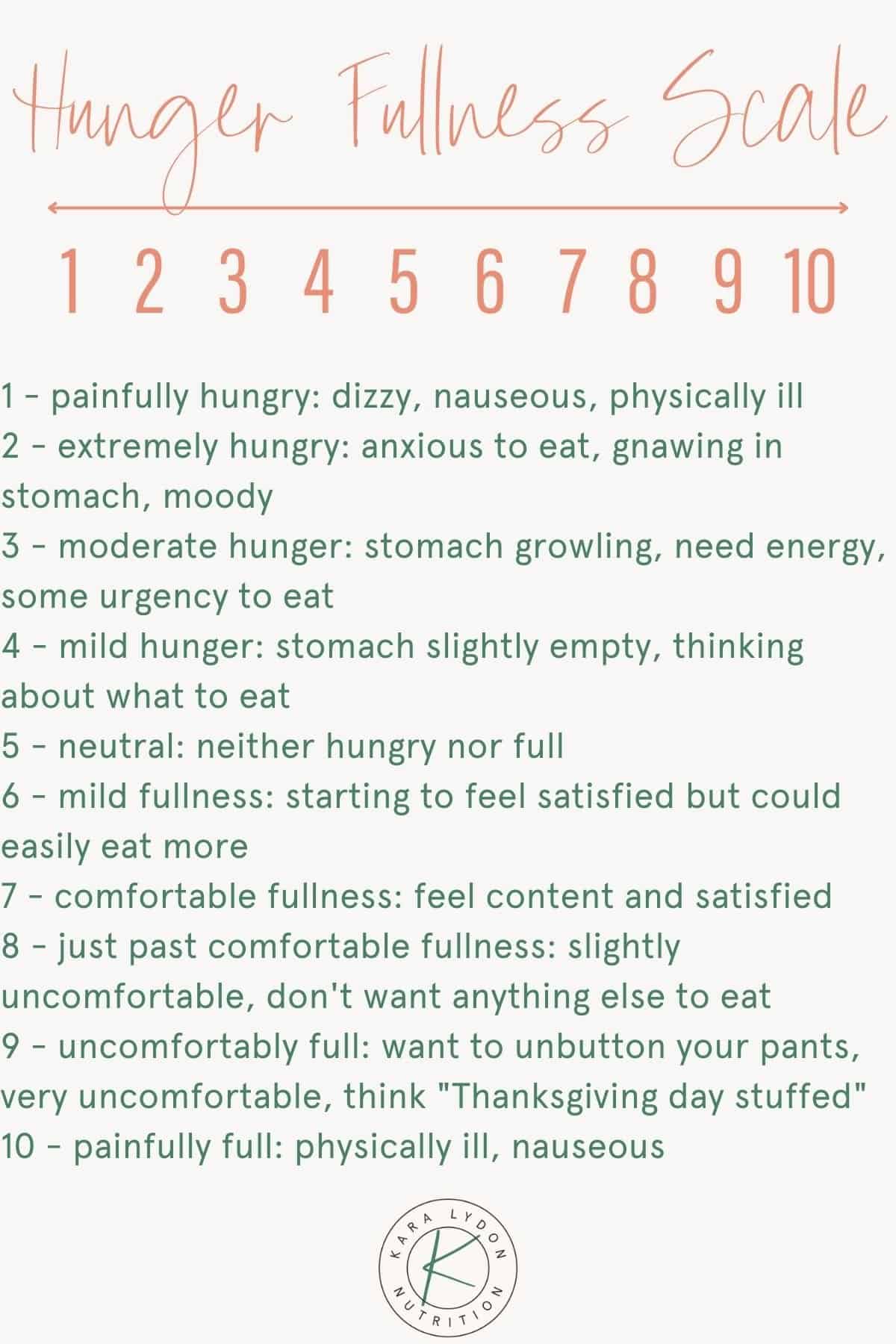
The hunger fullness scale is numbered 1-10 with 1-4 representing degrees of hunger and 6-10 representing degrees of fullness (and 5 being neutral).
1-2: overly hungry
3-5: starting to notice / noticing hunger
5-7: starting to notice / noticing fullness
8-10: overly full
Ideally, you want to aim to honor your hunger (aka eat!) when you’re at a 3 or 4 on the scale before you enter overly hungry territory. And ideally you want to aim to feel your fullness (aka stop eating) when you’re around a 7-8 on the fullness scale.
If journaling feels okay to you (this can feel triggering to some!), maybe you jot down where you are on the scale before and after a meal so that you remember to check-in with yourself before and after eating and so you can begin collecting some data to better understand how and when hunger and fullness show up in your body. You might start to notice patterns like:
- how long a meal generally holds you over
- how long a snack generally holds you over
- how long it generally takes before you reach a comfortable level of hunger
- how long it generally takes before you reach an uncomfortable level of hunger
- what types of foods generally hold you over longer
- what types of foods generally leave you still feeling hungry
- how subtle hunger generally shows up in your body
- how comfortable fullness generally feels in your body
I intentionally used the word generally above because hunger and fullness are dynamic, meaning they can change from day-to-day and week-to-week. You might have a couple days where you’re more hungry for some reason and that’s totally normal.
Don’t expect your hunger / fullness cues to be the same each and every day. You’re not the same every single day – your physical, mental, energetic, and spiritual states are constantly shifting – so why would we expect your hunger and fullness cues to be the same all the time?
Practice grace and compassion when things shift and you’re unsure why. Trust your body’s wisdom.
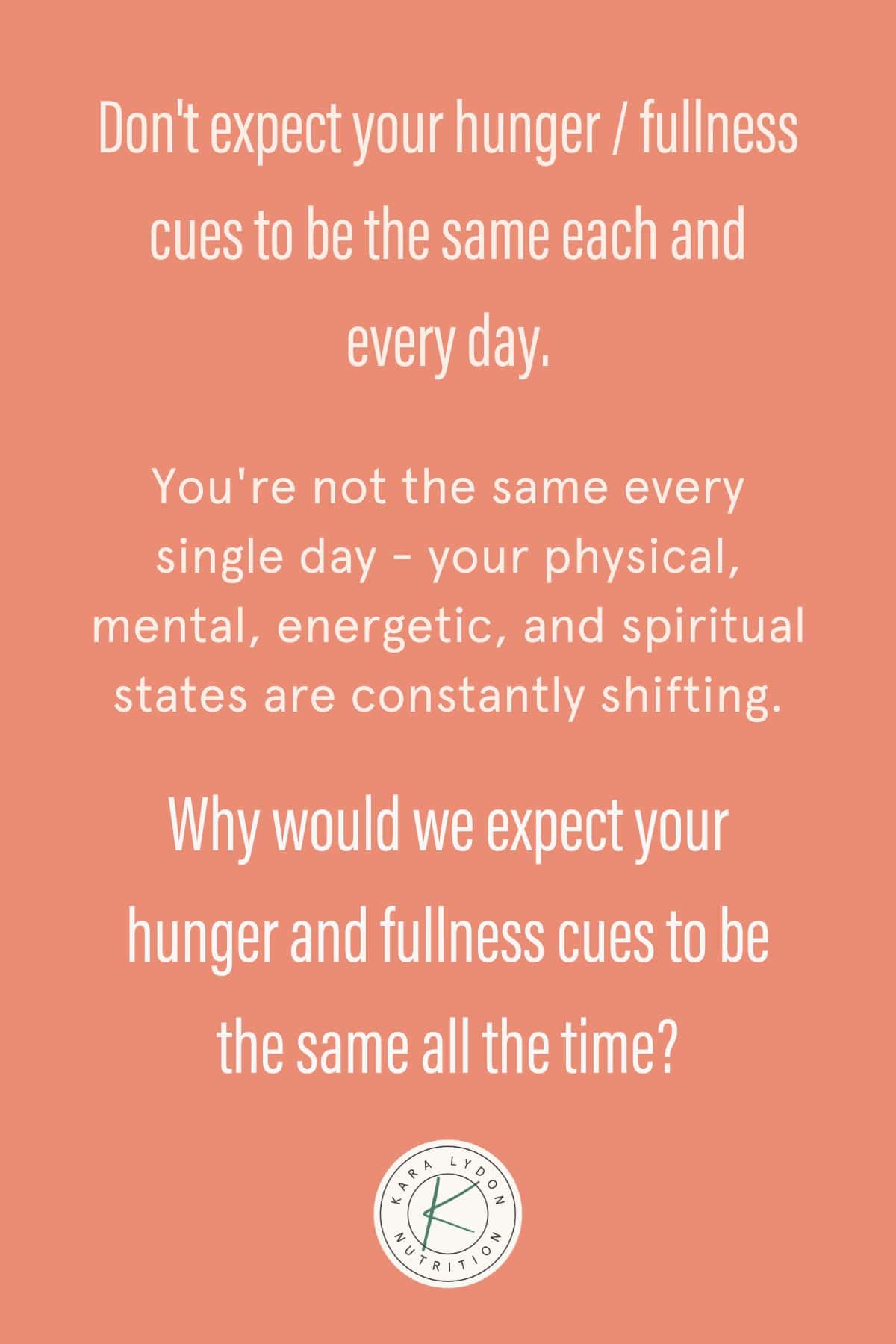
Be careful to use this as a tool, not a rule
Are you going to “get it right” all the time? Definitely not. You’re not a robot. You’re a human! Part of being a normal / intuitive eater is missing the mark from time to time. Some days you’ll forget to eat until you’re at a 2 on the hunger scale and other times you’ll be too distracted or so overly hungry that you overcompensate and end up at a 9 on the fullness scale.
It happens. It’s nothing to beat yourself up over. Get curious and ask yourself “what can I learn from this experience?”
Maybe you learn that you can’t go longer than 3 hours without eating and so you need to pay attention to the clock in addition to listening to your body. Intuitive eating is all about bridging your body knowledge with your brain knowledge.
After years of dieting, it can be easy to fall back into black-and-white thinking around intuitive eating and this scale. So easy that I even wrote a whole post about are you on the hunger fullness diet?
If you’re finding yourself using this scale as a hard-and-fast rule or something to perfect, you might be falling into an all-or-nothing mentality trap.
Remind yourself that this scale is only meant to be used as a tool or a guide, not something to perfect or stress out over.
If you find that this scale is giving you anxiety or causing you stress, take a break from it, and maybe try practicing another principle of intuitive eating for a while, like ditching the diet mentality. And of course always remember that you don’t have to practice all of this on your own. You are worthy of support and our team of dietitians would love to help you on your intuitive eating journey.
Why the scale might be hard to use
There are a number of reasons why you might not want to use this scale or why it might not be accessible for you to use at this time.
If you are currently in recovery from an eating disorder and working on nutrition rehabilitation, you will need to continue with mechanical / structured eating until you have been adequately nourished / in recovery for long enough to begin eating according to your body’s physical cues.
This is a decision that you can come to in conjunction with your treatment team. That’s not to say you can’t practice intuitive eating at all while you’re recovering – there are other principles you can practice – but hunger and fullness cues aren’t reliable when you’re early on in your recovery journey.
Folks who have a history of trauma might have trouble attuning to their body because it doesn’t feel safe to do so. This is another scenario in which structured eating would be most supportive in tandem with working with a trauma-specialized therapist.
Stress, in general, can interrupt attunement to your body. If you’re constantly in a heightened state, or in fight-flight-freeze-fawn mode, you might not be able to notice sensations in your body. Practicing self-care and/or using tools to help regulate your nervous system might help you be better equipped to tune inward and listen to your body.
If you are struggling with listening to your body because you ignored it for so long while dieting, you can begin to practice interoceptive awareness outside of noticing hunger and fullness cues.
Maybe you begin to notice your pulse by placing a couple fingers on your wrist. Next, maybe you place your attention on your heart beating. Perhaps you begin to notice where you feel various emotions in your body – maybe you feel anxiety in your gut and you feel sadness in your chest space.
These exercises can help to strengthen your interoceptive awareness so that you can slowly begin to notice your hunger and fullness cues again.
For more support and resources
Check out the following blog posts for more support and/or book a nutrition assessment with one of our intuitive eating dietitians. We’d love to help you on your journey to healing your relationship with food.
For more blog posts like this check out:
The Science on Dieting and Weight Loss
The Beginners Guide to Intuitive Eating
Am I Hungry? Signs of Hunger to Watch For
Am I Eating Enough? 8 Signs You’re Undereating
Are you on the hunger fullness diet?

